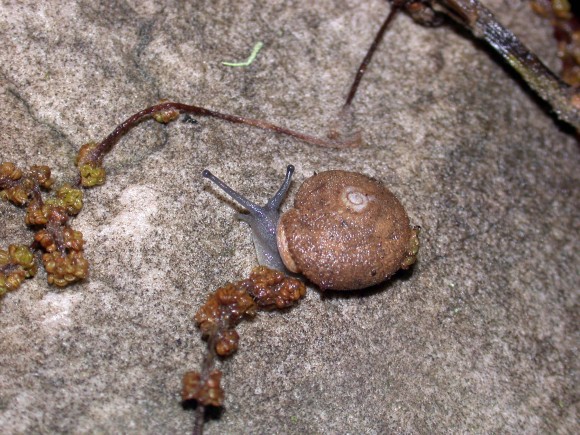For the first time in the history of the U.S. Endangered Species Act, an invertebrate is on target to be declared as a recovered species. The Magazine Mountain shagreen snail (Inflectarius magazinensis; formerly Mesodon magazinensis) lives only on the slopes of a 3,000-foot mountain that rises almost vertically from the floor of the Arkansas River Valley, in Logan County, Arkansas. The dusky brown or buff-colored terrestrial snail lives on the north and west slopes above 2,200 feet of Magazine Mountain. In all, there are only 21.6 acres at 27 talus (a sloping mass of loose rock) habitats where the snail has been found. You can see its species profile from the National Fish and Wildlife Service here.
Listed as threatened in 1989, the Magazine Mountain shagreen snail is difficult to count, so total population estimates are unavailable. Counting snail is complicated because of limited habitat, practicalities of surveying a nocturnal species, effects of temperature and humidity on snail activity, and the snail’s rupicolous nature (living or growing on or among rocks). Instead of a population count, the species has been monitored in regular counts of individuals at designated stations and surveys between 1998-2011 show a stable population.
Check out the proposal to delist the snail here.

The main reason for placing the Magazine Mountain shagreen snail on a threatened list was lost of habitat due to a military proposal to conduct troop and heavy equipment movements and artillery operations on Magazine Mountain; loss of habitat due to development of a new state park on Magazine Mountain that would include construction of new buildings, roads, and trails; increased recreational use due to development of the state park; U.S. Department of Agriculture Forest Service (USFS) use of the land; and increased vulnerability to collecting and adverse habitat modification due to the species restricted range. In other words, the snail’s habitat was threatened in multiple ways.
One of the main means of securing the habitat was a Memorandom of Understanding (MOU) between the USFS Ozark-St. Francis National Forest and the Fish and Wildlife Service that provides for long-term cooperation in the management and protection of the species. Magazine Mountain was also named a Special Interest Area, which prohibits timber harvest, prescribed burning from leaf fall until the end of the Magazine Mountain shagreen’s reproductive period, application of aerial fire retardant, road construction, and recreational development on talus slopes.
As part of the recovery plan, the snail was studied in depth for the first time, resulting in a better understanding of its life-history and habitat parameters. The snail prefers moist woods and lays egg-masses in leaf litter, with about 10-13 eggs per mass. Eggs hatch after a five-week incubation period. They feed on oak catkins (flowers) and other local vegetation.
The public was invited to comment on the delisting proposal for 60 days. Public input closed on August 20, and the proposal to remove the snail from Threatened Status will receive a final ruling in November 2012.
Nationally, the Fish and Wildlife Service is monitoring and working to recover about 600 listed animals, with over a third of them invertebrates. If this rule is finalized, the Magazine Mountain shagreen will be the first invertebrate determined to have met its recovery goals for the Service.
Also from Darcy Pattison: Two famous albatross checks on Midway Atoll in 2012











